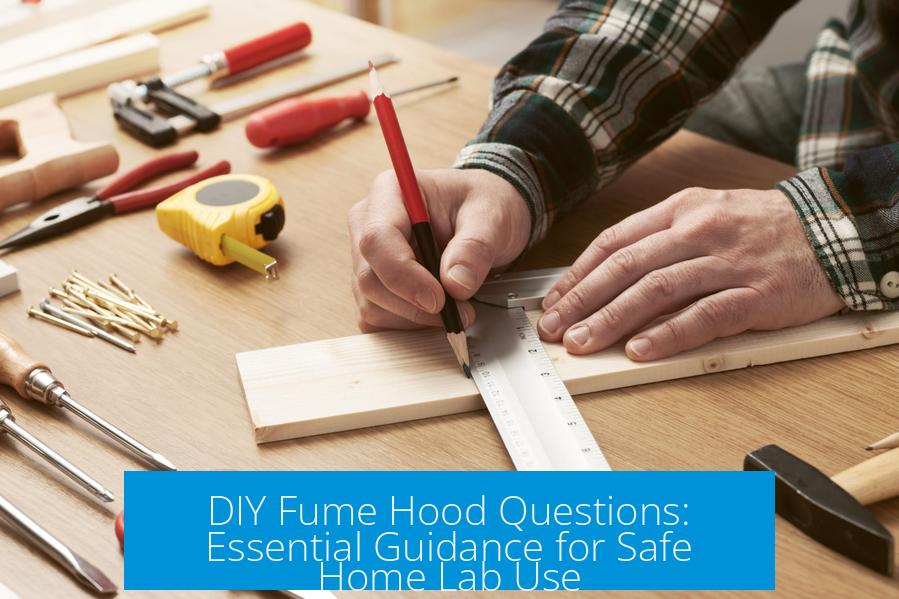DIY Fume Hood Questions: Essential Guidance for Safe Home Lab Use

DIY fume hoods require careful design and construction to ensure safety, proper airflow, and effective removal of hazardous fumes. This article addresses key questions regarding blower placement, ducting, sash design, airflow verification, chemical handling, materials, cost, and general safety concerns relevant to home or amateur laboratories.
Blower Placement and Ducting
The blower placement is critical for maintaining negative pressure inside the fume hood and preventing leaks into the house. Experts recommend positioning the blower outside the window or tightly against the window’s interior side. This way, the ductwork remains under vacuum, minimizing risks of fumes escaping indoors.
For example, converting a ductless Labconco fume hood to a ducted system often involves replacing costly filters with an effective exhaust duct. A common approach uses flexible, 4-inch diameter metal laundry dryer ducting. This duct runs across ceiling space—about 150 inches in typical setups—connecting the hood to an exterior outlet. This setup efficiently expels fumes outdoors and reduces indoor contamination risks.
In some cases, hobbyists attach a removable exterior blower at the exhaust exit. This additional unit activates when handling especially toxic substances and complements the pre-scrubbing filtration inside the hood.
Many emphasize consulting a professional HVAC technician for duct system design. Proper consultation helps avoid leaks and ensures sufficient suction force from secondary blowers, critical for effective fume extraction and user safety.
Sash Design and Airflow Management
The sash acts as a physical barrier between the user and experimental substances. A movable sash that covers most of the hood’s front keeps hazardous vapors contained. Transparent materials such as Plexiglas or polycarbonate are preferred for visibility.
Airflow must be balanced by maintaining the proper gap between the sash and hood. Typically, a 6-inch opening ensures adequate air movement into the hood, preventing vapors from escaping.
Airflow Verification Techniques
Ensuring constant and inward airflow is essential. Simple airflow tests help verify hood performance.
- A strip of tissue placed at the hood opening will flutter inward if airflow is sufficient.
- Performing a smoke test accurately visualizes airflow paths and potential backflow occurrences.
Backflow from external wind or duct misalignment can drive fumes back into the room. Testing helps identify and correct these issues early.
Chemical Handling and Safety Considerations
Fume hoods provide secondary protection by capturing fumes after initial treatment. Toxic substances should be neutralized or absorbed before release inside the hood. For instance, excessive ozone from an experimental generator was safely scrubbed by ducting gases through a jar containing olive oil and pebbles. The oil absorbs ozone effectively but can heat up and smoke as a reaction byproduct, illustrating the importance of managing exhaust fumes.
Handling noxious gases responsibly prevents harm to neighbors and the environment. Projects in a home lab must minimize toxic emissions. Local pollution regulations must be respected. Owners should have plans for filtration or scrubbing exhaust gases when necessary.
Amateur chemists are cautioned against recklessly venting hazardous gases outdoors. Careful planning and chemical knowledge are essential to avoid legal and environmental issues.
Materials and Construction Recommendations
Material choice significantly affects hood durability and cost. High-density polyethylene (HDPE) sheets are recommended for lining the hood’s bottom surface. HDPE is chemical-resistant and easy to clean, making it suitable for lab environments.
With proper craftsmanship and materials, a functional hood can be built for under $1,000. This contrasts sharply with commercial fume hoods, which often exceed $10,000 and come with professional testing certifications.
While commercial units carry hefty price tags due to safety testing and regulatory compliance, a well-executed DIY hood can offer reliable protection for low-risk projects.
Cost and Safety Considerations
Safety remains the paramount concern for professional and hobbyist chemists alike. Home labs carry inherent risks—the potential for exposure to toxic, flammable, or corrosive substances.
Commercial-grade fume hoods represent significant investments justified by robust engineering, certifications, and integrated safety features. Additionally, professional labs invest heavily in personal protective equipment (PPE) and ongoing maintenance to ensure safe working conditions.
Hobbyists should recognize the limitations of DIY setups and prioritize safety training, proper ventilation, and emergency planning. For serious chemical work, university or industrial lab environments provide superior resources and safety support.
Community Experience and Shared Advice
The increasing number of amateur scientists practicing with safety in mind suggests growing awareness. Within communities, feedback often includes:
- Sharing design improvements for sash and ducting.
- Reporting successful airflow tests and problem-solving techniques.
- Exchanging personal anecdotes about chemical scrubbing and filtration systems.
- Advising on engaging professional consultations when in doubt.
Such community contributions help beginners avoid common pitfalls and enhance overall lab safety.
Summary of Key Takeaways
- Blower placement outside or flush with a window ensures duct under vacuum, reducing leaks.
- A movable sash with a visible barrier and a 6-inch air gap maintains effective airflow and containment.
- Airflow verification via tissue strips and smoke tests confirms proper hood performance.
- Toxic gases should be treated or scrubbed before release; adhere to local pollution laws.
- HDPE is a recommended lining material for durability and chemical resistance.
- DIY hoods can be cost-effective but require careful design and safety awareness.
- Consult professionals for HVAC and ductwork to prevent leaks and maintain suction.
- Commercial hoods are expensive due to safety certification and robust features.
- Respect chemical hazards and ensure proper PPE and emergency preparedness.
- Engage with community resources for design tips and safety insights.





Leave a Comment